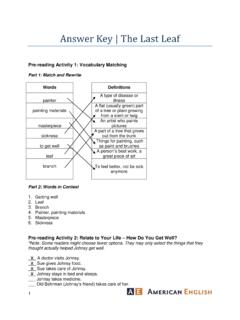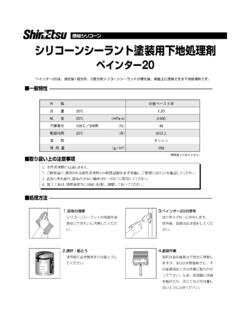Transcription of Child Labour Stories - International Labour Organization
1 CHILDLABOURSTORIESALEJANDRAT welve-year-old Alejandra is woken up at four in the morning by her father, Don Jos . She doesnot go to school, but goes to collect curiles, small molluscs in the mangrove swamps on the islandof Espiritu Santo in Usulutan, El the rush to get to work, Alejandra does not take time to eat breakfast. It is more importantto make sure she has the things she needs to make it through a workday that can meanspending up to 14 hours in the mud. These items include about a dozen cigars and at least fourpills to keep her from falling asleep. A good part of the money that she earns goes to buy the mangrove swamp without shoes, Alejandra has to face bad weather, mosquito bites andcuts and scrapes from having to pull the curiles out from deep in the mud.
2 The cigars help torepel the mosquitoes, but when she runs out of cigars Alejandra has to put up with the insectsas she moves from branch to branch and from one area to another in search of shells. When shereturns from work, her body is nearly always covered with bites. She earns very little. If she is lucky in one day Alejandra manages to collect two baskets of curiles(150 shells), worth little more than 12 colones, or $ Alejandra, who has seven youngerbrothers and sisters, has no time to go to school or play with other children. Anyway, she prefersnot to play with other children because they say she smells bad and exclude her from their gamesfor being a curiles by little Alejandra has lost her self-esteem.
3 Like the other children who work collectingcuriles, she feels separate from the rest of society. For Alejandra, life seems like a tunnel with though he is only 11 years old, Hamisi already has had a career as a miner. He dropped outof his third year of primary school and left his home village of Makumira in Tanzania after hisfather was unable to pay for his uniform and school fees. Although Hamisi's parents have theirown half-acre coffee farm, their income fell sharply because of the decline in the market pricefor coffee throughout the had heard Stories of people making money from mining and decided to try his luck. Heasked his mother for a small amount of money to buy some socks and other items, but insteadused this for the bus fare to Mererani, a town in northern Tanzania about 70 kilometres from hishome.
4 Personal StoriesInternationalLabour OfficeInFocus Programme on Promoting theDeclaration on Fundamental Principles and Rights at WorkWORK IN FREEDOMWhen he arrived at the village, he approached a boy and asked him where the mining site waslocated. It was very difficult for him to get work right away because he was a newcomer and hadno relatives there, but he managed to make friends with some children who knew the place andcould help him. After several days of hanging around the mining site, he was hired by one of owners to work asan assistant "errands" boy. The following day, he and another Child of his age were sent down intothe pit, where the gemstone Tanzanite was being mined, to deliver tools and bring up usedbottles of drinking that day, he worked as a service boy, going back and forth between the surface and thepits.
5 "You have got to get deep into the mining pit by a rope, take what you have been orderedand then go back to the surface," Hamisi inside of the mining pit, which can be as deep as 300 metres, is totally dark and extremelyhot. Those who go into the mine need to wear a special torch (or flashlight) on their foreheadsto find their way around. Their skin turns to black because of the humidity and heat as well asthe mud, Hamisi says."I nearly suffocated inside the pits due to an inadequate supply of oxygen," he adds. At themining sites and in the township children like Hamisi are called "nyokas", or "snake boys", becausethey crawl along the small tunnels underground just like snakes.
6 The health of the snake boys isvery poor, as they breathe in the harmful graphite dust found in the mines and they do not haveenough to eat. Hamisi often worked up to 18 hours a day with only one meal of buns and boiledor cooked working in the Mererani mines earn the equivalent of between 60 cents and $ aday when they are given tasks to do. Some children look through the gravel left by the pitowners in the hope of finding a gemstone. When they do, which is only very rarely, they can earnbetween $24 and $122. It is because of Stories of finding gemstones that children like Hamisi areattracted to the like many others, Hamisi was disappointed by the terrible conditions and he did not makethe fortune that he had heard can't see his hands in the darkness of his shack made from palm bark and zinc on ahillside in the Dominican Republic.
7 But he feels them because of the pain from wounds on his leftthumb caused by the knife he uses to trim garlic plants. It is dawn and he has to hurry if he is toget a place in the landowner's truck. He jumps from the worn mattress that he shares with threeother brothers. He doesn't have breakfast because there isn't any. Nor does he wear workingboots because he has manages to climb into the back of the truck before the others, who are adults and otherchildren like him, without a childhood. In the cold and fog, the icy wind cuts his unprotected doesn't look beyond his hands and forgets his discomfort. His hands are his most valuableworking assets. They pick potatoes, extract onions, dig up lettuce, behead beets and cut andgather garlic bulbs.
8 He knows that he can bring home between 80 and 120 pesos, or $5 to $7,to contribute to the low family income and to buy a pair of shoes. He works in the fields everyday from dawn to the middle of the does not go to school. For a short time a few years ago, when the family lived in themountains, he took a long and steep road to go to classes. "But, we were so far away that henever learned anything," says his mother, Viola Delgado. "How could he learn if with thesweating of the trek he forgot what he was taught in school?" A mother of eight children, the40-year-old Mrs. Delgado is illiterate, like her her hut, only a thin sheet separates the cramped "living room" from the beds.
9 A wooden tableand wobbly chairs make up the furnishings. Like other huts in El Chorro, there is no electricityor running water. There is no nearby faucet or toilet. El Chorro is on a hill above the Constanzavalley, which is the most fertile in the country. The people living in these huts, about five minutesfrom town, are farm workers who have come here because there is plenty of agricultural they remain poor because pay is so soon as they reach a certain height and age, the children go with their parents to theplantations. They are exposed to the excessive chemicals, or herbicides and pesticides, that areapplied to the fields. They are often barefoot and underfed -- they drink bottled refreshment tokeep them going during the workday.
10 The children are often says he would like to study and continue to help his family. His mother also would like himto go to school. "It's more advantageous for me if they go to school, even if they don't earnanything, for they don't make much with a day's work anyway." There are helpers and community workers in Constanza and El Chorro who are encouraging thechildren to go to school. They see a big difference in the children after just a short time at kids speak better, keep their notebooks tidy and are interested in school, not earning will soon be one of those children.

















